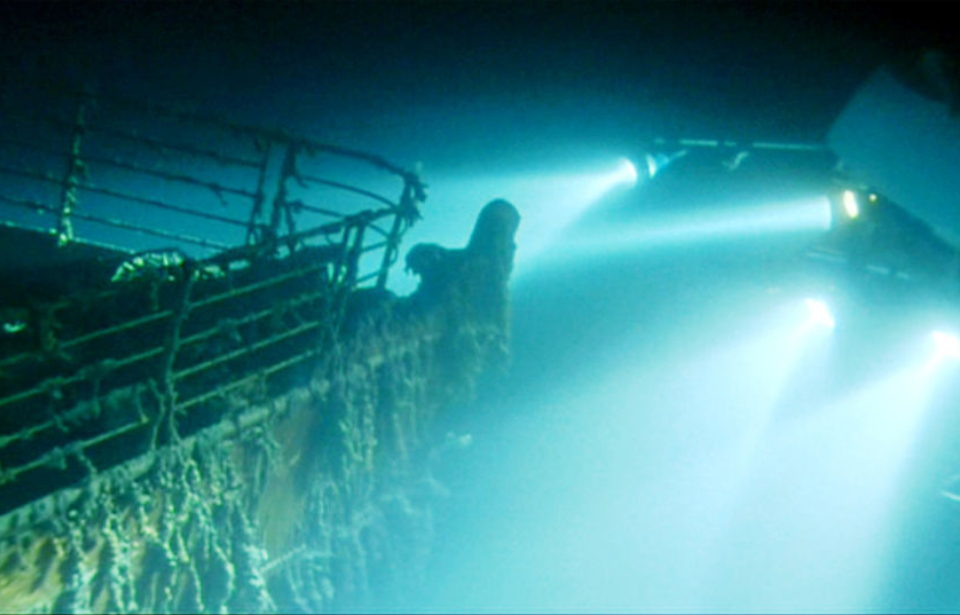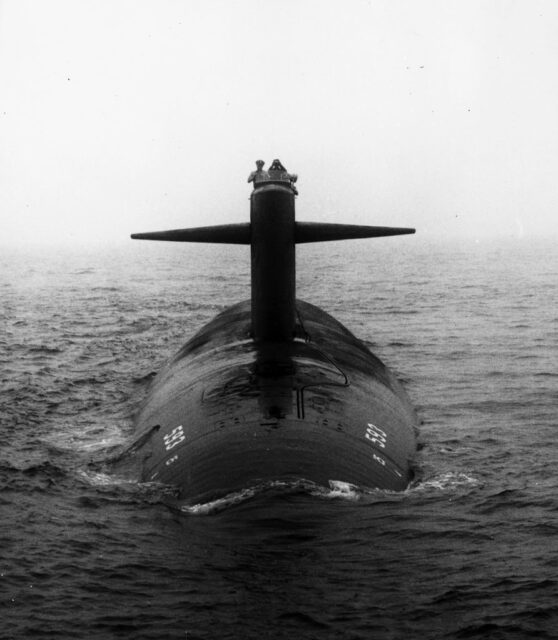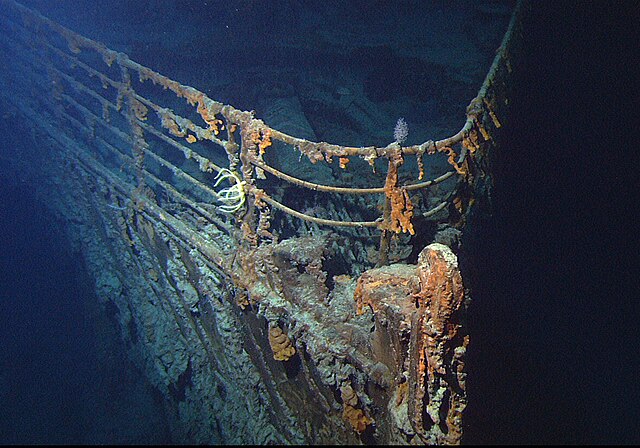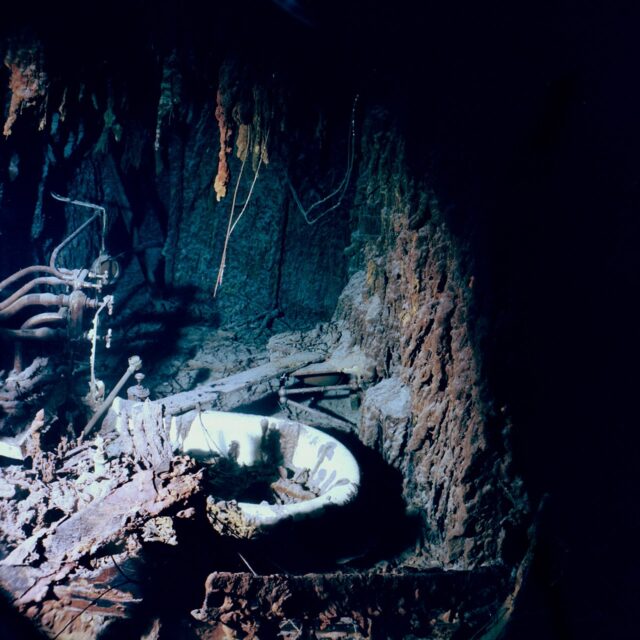The Wreck of the RMS Titanic Was Found During a Top-Secret Military Operation

The sinking of the RMS Titanic in April 1912 was one of the most tragic maritime disasters in history. As such, the discovery of the ocean liner’s wreck in the mid-1980s was big news. What the public didn’t know at the time was that the search had actually been a cover for a military operation: the search for the remains of two nuclear submarines.
Sinking of the RMS Titanic

RMS Titanic, 1912. (Photo Credit: Roger Viollet / Getty Images)
Believed to be unsinkable, the RMS Titanic departed Southampton, England, for her maiden voyage on April 10, 1912. The 2,224 passengers and crew were on their way to New York City, New York, but little did they know that, as they neared their destination, they’d never see the famed American city.
Five days into the voyage, in the early hours of April 15, Titanic struck an iceberg in the north Atlantic Ocean, just off the coast of Newfoundland. Given the speed the ocean liner was traveling, 22 knots, her crew had been unable to steer away from the iceberg in time, with the starboard side suffering the brunt of the impact.
Of the more than 2,000 people aboard Titanic, 1,500 lost their lives, largely to exposure to the cold weather. Just over 700 passengers were rescued by the RMS Carpathia, which arrived on the scene an hour and a half after the sinking.
One of the worst peacetime disasters in maritime history, the loss of Titanic saw widespread changes to regulations. It also resulted in the creation of the International Convention for the Safety of Life at Sea (SOLAS) in 1914.
Loss of the USS Thresher (SSN-593)

USS Thresher (SSN-593), 1961. (Photo Credit: National Archives / Interim Archives / Getty Images)
The USS Thresher (SSN-593) was a Thresher-class nuclear-powered attack submarine operated by the US Navy during the Cold War. The fastest submersible of her time, the vessel was constructed with the sole intention of locating and engaging with Soviet submarines, at a time when tensions between the United States and the Soviet Union were nearing a boiling point.
The early years of Thresher‘s service with the Navy were rather uneventful, with the submarine largely conducting tests and trials. But it was while performing a deep-dive test on April 13, 1963, that the vessel met her tragic end.
Some 220 miles off the coast of Cape Cod, Massachusetts, Thresher failed to surface, resulting in the deaths of the 129 crewmen and personnel aboard. The first nuclear submarine to be lost by the Navy, it was later determined that her sinking was the result of a piping failure, which subsequently caused power failure and the inability to effectively blow her ballast tanks.
Thresher‘s wreck was later located, approximately 8,400 feet below the water’s surface.
What happened to the USS Scorpion (SSN-589)?

USS Scorpion (SSN-589), 1960s. (Photo Credit: Pictorial Parade / Getty Images)
The USS Scorpion (SSN-589) was a Skipjack-class nuclear-powered submarine that had a near decade-long service career with the US Navy. In May 1968, she and her crew were tasked with intercepting a Soviet naval task force near the Canary Islands, as the USSR had been performing espionage activities in the region. On May 21, her crew reported they were 50 miles south of the Azores. Six days later, the submarine had failed to report back.
After a search, Scorpion and her 99-man crew were declared “presumed lost” on June 5. The Navy refused to publicize what the submarine was doing at the time she went missing, with officials saying she’d been on a routine mission. In their cover-up, none of the higher-ups could explain what had happened to the vessel, stating decades later, in 1993, that flooding had likely occurred aboard Scorpion, at which point she suffered a “cataclysmic event” or explosion.
Many years later, Vice Adm. Arnold F. Schade revealed the context of Scorpion‘s missing, explaining that her crew had appeared to be in good shape prior to the submarine sinking. He also shared the reasoning behind the theory the vessel had suffered some kind of explosion, saying a secret system had tracked both the incident and a Soviet submarine that left the area soon after.
Scorpion‘s wreck was subsequently located in the north Atlantic. Her nuclear reactor and armaments are still aboard the sunken submarine.
How are the three vessels connected?

Wreck of the RMS Titanic, 2004. (Photo Credit: NOAA / Institute for Exploration / University of Rhode Island / Wikimedia Commons / Public Domain)
The discovery of the wreck of the RMS Titanic in 1985 made news worldwide, but the public didn’t know that locating the sunken ocean liner wasn’t the expedition’s primary objective. The team involved, including Robert Ballard of the Woods Hole Oceanographic Institution, had been tasked with locating the wrecks of the USS Thresher and Scorpion, under the guise they had set out to find Titanic.
Now, it’s not like Ballard and his crew didn’t want to find Titanic – that’s all they’d wanted to do – they just needed to do this little side quest for the US Navy. The lie that their intention had only been to find the ocean liner was to prevent the Soviet Union from tracking them and coming across the sunken nuclear submarines.
Once the team had located the wrecks and gathered data about their nuclear reactors, Ballard’s team had 12 days to find Titanic. While he later said the Navy didn’t expect them to locate the ship, they did just that – and this worried the military branch. The publicity the discovery would receive could very well lift the cover off of the expedition’s primary goal.
As it turns out, the public never learned about the examination of Thresher and Scorpion‘s wrecks. While The New York Times had raised some suspicions, given the use of naval equipment in the expedition, Navy spokesperson Capt. Brent Baker said the endeavor was used to test the effectiveness of the service’s oceanographic technology.
Bringing the true nature of the expedition to light

Wreck of the RMS Titanic, 2004. (Photo Credit: Lori Johnston / NOAA-OE / Wikimedia Commons / Public Domain)
The real purpose of the expedition was revealed in 2018, when the National Geographic Museum in Washington, DC, put several declassified files about the event on public display. This gave Robert Ballard the opportunity to speak candidly about that time in his life.
In an interview with CNN, Ballard revealed how he and his team came to work with the US Navy. According to him, he’d needed money to fund his search for the RMS Titanic, but had failed to secure a scientific grant. This led him to turn to then-Deputy Chief of Naval Operations Ronald Thunman, who was open to funding the expedition, but on one condition: his team had to first locate the USS Scorpion and Thresher, so their reactors could be examined.
More from us: 10 Photos That Show US Navy Ships During Their Prime and Following Their Retirement
“They didn’t want the world to know that, so I had to have a cover story” – and what a cover story it was!





